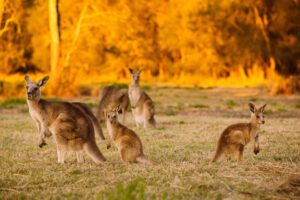The preferred habitats of a wombat is hilly or mountainous coastal country, creeks and gullies. Wombats are herbivores and feed up on grass, roots of shrubs and tress and fungi. They can graze for up to 8 hours a night and travel quite far from their burrows in search of food.
Wombats are burrowers and will dig out burrows measuring 30 metres (100 feet) long. Burrows will have one entrance but may branch out into different chambers. The wombat makes its nest in one of these chambers and it will be lined with grass, bark and leaves.
They are usually nocturnal but will sometimes bask in the sun in specially prepared spots close to the entrance of its burrow. Wombats live in large home ranges and although they tend to be solitary, neighbouring territories can overlap considerably.

Although wombats are sometimes aggressive towards each other in captivity, some observations suggest that they often make visits to each others burrows in the wild. When a wombat is startled or threatened, they can flee at around 25 miles per hour and maintain this speed for up to 90 seconds. Main predators of wombats are Tasmanian Devils and Dingoes.
They reach sexual maturity at 2 years of age. Births occur in late Autumn when 1 – 2 young are born after a gestation period of 20 – 28 days. Like all marsupials, wombat babies (joeys) are born under-developed and immediately enter its mothers pouch where it will stay attached to a teat, suckling milk, until it is fully developed. The young usually leave the pouch when they are 6 – 7 months old and are weaned after 15 months.














